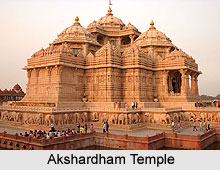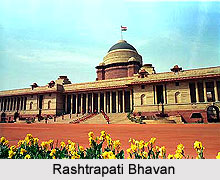 The architecture of Delhi has a rich heritage which includes the imperial Mughal architecture and also the gothic style of architecture incorporated by the Colonisers. Being the capital city, Delhi has been the seat of power for various dynasties and has thus witnessed an amalgamation of different cultures and tradition at various times in history which has resulted in the diverse architectural style of Delhi. Even post independence there are some exquisite architectural specimens that has being constructed in Delhi such as the brand new Akshardham temple built on the immaculate banks of river Yamuna.
The architecture of Delhi has a rich heritage which includes the imperial Mughal architecture and also the gothic style of architecture incorporated by the Colonisers. Being the capital city, Delhi has been the seat of power for various dynasties and has thus witnessed an amalgamation of different cultures and tradition at various times in history which has resulted in the diverse architectural style of Delhi. Even post independence there are some exquisite architectural specimens that has being constructed in Delhi such as the brand new Akshardham temple built on the immaculate banks of river Yamuna.
History of architecture in Delhi has a mythological past which dates back to the period of Mahabharata, the Indian epic. Delhi has been mentioned there as a city named Indraprastha. Mahabharata speaks volumes of the beautiful architecture that the city was endowed with. In reality too the architectural heritage of Delhi is ornate and majestic. There are both secular and sacred architecture in Delhi which is a magnanimous array of Mughal forts, towering temples and monuments representing Gothic architecture. Major architectures of this city began with the advent of the Muslim rulers.
The first Muslim building to be constructed in Delhi was the Quwwat-ul-lslam Mosque, built in 1206 A.D. by Qutb-Ud-Din Aibak who started the Slave Dynasty. The construction was based on Islamic style of architecture but more proficient traditional Muslim construction techniques are seen in the tomb of Iltutmish and in Alai Darwaza. The Qutub complex is an excellent example of Indo- Islamic style of architecture. The buildings were constructed by destroying Hindu and Jain temples because depiction of animals and human figures on the wall is not permitted in Islam. There is not much decoration on the inside of the mosques in Delhi but the sturdy pillars, support true arches which look more archaic and are a step closer to genuine Islamic architecture. The tomb of Ghiyas-ud-din Tughlaq is an important architectural specimen of Delhi.
In the Mughal era there were considerable modifications in the architecture of Delhi for example the garden architecture or Char bagh was introduced in India by the Mughals. One of the earliest constructions of the Mughal era is Tomb of Humayun. It is a large complex, with a garden on four sides and the mausoleum in the middle. Red sand stone and marble were extensively used as materials for construction. The Red fort for example is built of red colour sandstones. The inside of the fort was a town and even now, the road that leads to Lahore gate, is lined with shops as in a castle market. The structures highlight the care given to detail in Mughal construction. The royal prayer room called the Moti Masjid is a small marble structure built in the Baroque style. The Jama Masjid in Delhi is the biggest mosque in India is built in a combination of red sandstone and marble and has three domes crowning it. The construction style of Jama Masjid is similar to that of Humayun`s Tomb. The Jantar Mantar of Delhi is built as per the Rajput style of construction by Maharaja Sawai Jai Singh II, the ruler of the Rajput state of Amber.
The capital of India was shifted from Kolkata to Delhi by the Britishers and they re-named it as New Delhi which is to the south of the old city. Under the colonisers the architecture of New Delhi was designed systematically by combining the elements of Gothic, imperial, English renaissance and Victorian style of architecture. The Rashtrapati Bhavan or the Viceroy"s house in Delhi is a classical European building with some features of Mughal architectural style. The Secretariat, built in the western classical style is a set of twin buildings that face each other in front of Rashtrapati Bhavan. The British National Church was devoid of any influences of Indian traditional style and the structure is very neat and graceful.
 Post independence a number of buildings have been built in Delhi which has enhanced the architectural exquisiteness of the place. Architectural monuments and buildings after independence were still inspired by the British architecture but also incorporated certain indigenous elements. The towering Jeevan Bharti building for instance is a splendid creation in glass, metal and stone. The State Trading Corporation building is built with an inspiration drawn from traditional Indian architecture. It has a blend of red and yellow sandstone which draws from Mughal architecture. The Scope Office complex is set up on a large area and each of the buildings have their own unique character, while at the same time, stand together, to form a composite whole. The Akshardham temple complex on the bank of Yamuna River was completed in the year 2005 and displays traditional Indian and Hindu architecture.
Post independence a number of buildings have been built in Delhi which has enhanced the architectural exquisiteness of the place. Architectural monuments and buildings after independence were still inspired by the British architecture but also incorporated certain indigenous elements. The towering Jeevan Bharti building for instance is a splendid creation in glass, metal and stone. The State Trading Corporation building is built with an inspiration drawn from traditional Indian architecture. It has a blend of red and yellow sandstone which draws from Mughal architecture. The Scope Office complex is set up on a large area and each of the buildings have their own unique character, while at the same time, stand together, to form a composite whole. The Akshardham temple complex on the bank of Yamuna River was completed in the year 2005 and displays traditional Indian and Hindu architecture.
Delhi, thus, exhibits an opulent bouquet of architectural heritage that dates from mythological past to the present day. The architectural specimens vary from Mughal forts to temples to colonial pattern of buildings. Even the post colonial architecture are quite awe inspiring and makes Delhi a pivotal place for architectural magnificence on the map of India.



















